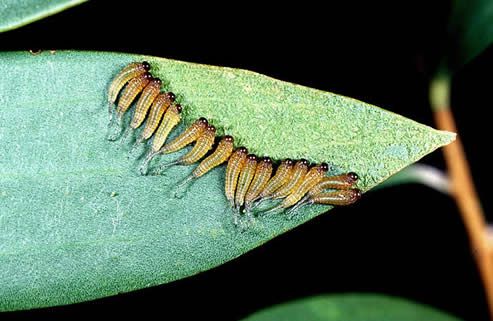Sawflies
Sawflies are a small non-stinging wasp and their young are larvae, which is the only life stage that does any damage. Sawfly larvae are small and caterpillar like in their appearance, although they are not true caterpillars. They feed on a wide range of plants and they cause the most damage to younger plant specimens
Culture
There are many different kinds of sawflies, which make them able to feed on a wide variety of plants. They feed in large groups and damage can be severe and almost overnight. They feed from May to September for 2-3 weeks when they are in larval stage, and then they change into adult flies and the feeding stops.
Plants they feed on
 |
|
Day old sawfly larvae are systematically eating this leaf. They are only destructive as larvae.
|
Spruces and Pines
This fly attacks the new and old needles and will defoliate an entire section of a branch before moving on. Feeding is from June to August can severely damage the tree and may even cause death.
Roses
This fly will skeletonize the leaves of roses, which is very easy to spot. They will feed from May to June. Stresses from feeding will usually only effect younger roses.
Ash
This fly will eat the entire leaf except for the veins, but will usually not kill a mature tree. Feeding is from June-September.
Control
The only time that sawflies can be controlled is during their larval stage while they are feeding. Once the larvae turn into adult sawflies, no insecticide can affect them.
It is important to scout out your plant during the spring when the larvae are young and beginning to feed. Check plants that are most susceptible to sawfly larvae attacks.
Control with insecticides such as Eight.
Spray only the plants that are infested with the larvae at the time. The flies and larvae tend to stay on one plant for their entire feeding time. Check surrounding plants regularly just in case.
